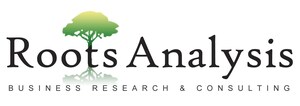With the rising demand for more efficient and homogenous antibody drug conjugates, drug developers are increasingly collaborating with technology providers, for leveraging their advanced ADC conjugation platforms
LONDON, Aug. 23, 2023 /PRNewswire/ -- Roots Analysis has announced the addition of "Antibody Drug Conjugates: Focus on Linker and Conjugation Technologies (2nd Edition), 2023-2035" report to its list of offerings.
Despite the growing adoption, limitations of conventional antibody drug conjugates and related technologies, such as low safety and efficacy, unstable DAR and off-site toxicity, have prompted innovators to look out for more advanced antibody drug conjugate linker and conjugation technologies. Driven by the growing demand for antibody drug conjugates and the ongoing technological advancements, the ADC linker and conjugation technologies market is poised to experience noteworthy growth over the coming years.
To order this 400+ page report, which features 140+ figures and 200+ tables, please visit this link
Key Market Insights
Presently, more than 65 firms claim to offer ADC linker and conjugation technologies to the pharmaceutical / biotechnology companies and academic institutes
Majority (45%) of the ADC linker and conjugation technology providers are headquartered in North America. Further, ~50% of the technology providers are start-ups with employee count ranging between 2-50.
Over 95 ADC linker and conjugation technologies are available / being developed for the targeted delivery of cytotoxic payloads to the tumor cell
Majority (54%) of the technologies are third-generation. Further, 50% of the technologies offer chemical based site specific conjugation of antibodies to potent payloads.
Till date, 14 antibody drug conjugates have received the USFDA approval, and more than 420 antibody drug conjugates are currently being evaluated under different stages of development
Of these, 47% of the antibody drug conjugates are under discovery / pre-clinical stage of development. More than 75% of the antibody drug conjugates are being developed for targeting solid tumors, including breast cancer and lung cancer.
Partnership activity in this field has grown at a CAGR of ~85%, between 2020 and 2022
Close to 60% of the partnerships were established for licensing of ADC linker and conjugation technologies for development of various novel targets. Further, around 11% of the total deals inked between stakeholders in this industry were intended for research and development purposes.
Several business strategies have been adopted by stakeholders engaged in this industry, between 2014 and 2023
Technology out-licensing is the most prominent business strategy adopted by players in this industry. This is followed by collaborative research and product out-licensing business strategies.
Since 2018, more than 2,100 patents have been filed / granted for ADC linker and conjugation technologies
Close to 60% of the patent applications have been filed post 2020. It is worth noting that around 35% of the patents were filed by / granted to the players headquartered in Asia-Pacific region, followed by North America.
North America is anticipated to capture larger share of the ADC technology market by 2035
Currently, North America captures the highest market share (~40%), in terms of revenues generated from technology licensing deals, while the ADC linker and conjugation technologies market in Asia-Pacific and rest of the world is likely to grow at a CAGR of ~13%, till 2035.
To request a sample copy / brochure of this report, please visit this link
Key Questions Answered
- Who are the key technology providers in ADC technology domain?
- Which type of ADC conjugation technologies are most commonly offered by players in this market space?
- What are the key factors driving the adoption of ADC linker and conjugation technologies?
- What is the relative competitiveness of different technologies offered by companies engaged in this domain?
- Which partnership models are commonly adopted by stakeholders offering ADC linker and conjugation technologies market?
- Which companies are actively filing patents to drive innovation in the ADC linker and conjugation technologies market?
- Which are the top companies engaged in the ADC linker and conjugation technologies market?
- What are the strategies that can help emerging players / start-ups to enter this market?
- How is the current and future opportunity likely to be distributed across key market segments?
The financial opportunity within the ADC technology market has been analyzed across the following segments:
- Generation of Technology
- Third-Generation
- Second-Generation
- Next-Generation
- Type of Conjugation
- Chemical
- Chemoenzymatic
- Enzymatic
- Type of Linker
- Cleavable
- Non-cleavable
- Type of Payment Model Adopted
- Upfront Payments
- Milestone Payments
- Key Geographical Regions
- North America
- Europe
- Asia-Pacific and Rest of the World
The research includes brief profiles of key players offering ADC linker and conjugation technologies; each profile features, an overview of the company, details related to its offerings, recent developments and an informed future outlook:
- Alteogen,
- Ambrx,
- Antikor,
- Catalent Biologics
- Heidelberg Pharma
- Iksuda Therapeutics
- LegoChem Biosciences
- Mersana Therapeutics
- NBE-Therapeutics
- Seattle Genetics
- Sutro Biopharma.
For additional details, please visit https://www.rootsanalysis.com/reports/adc-technologies-market/287.html or email [email protected]
You may also be interested in the following titles:
- Conjugation and Labeling Services Market: Industry Trends and Global Forecasts, 2023-2035
- Bispecific Antibodies Market: Industry Trends and Global Forecasts, 2023-2035
- Nanoparticle Formulation Market: Industry Trends and Global Forecasts, 2023-2035
Contact:
Gaurav Chaudhary
+1 (415) 800 3415
+44 (122) 391 1091
[email protected]
Logo: https://mma.prnewswire.com/media/742223/Roots_Analysis_Logo.jpg
SOURCE Roots Analysis

WANT YOUR COMPANY'S NEWS FEATURED ON PRNEWSWIRE.COM?
Newsrooms &
Influencers
Digital Media
Outlets
Journalists
Opted In





Share this article